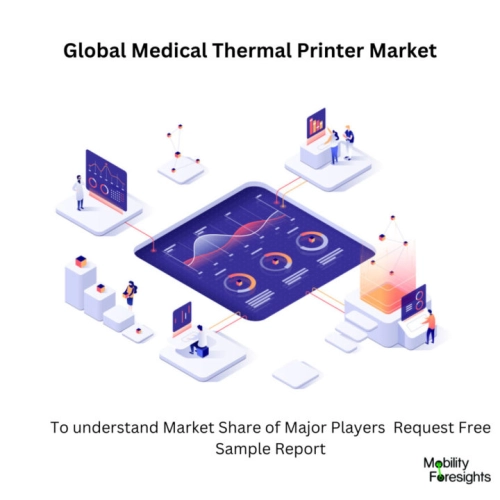
- Get in Touch with Us

Last Updated: Apr 25, 2025 | Study Period: 2023-2030
Thermal printers, in contrast to inkjet printers, use a heated printhead to create images. Most types only print in one or two colours and employ material of various sizes that is not compatible with desktop printers. Direct thermal and thermal transfer are the two fundamental forms that are available.
Labels or paper that is chemically modified and heat-sensitive are used in direct thermal printing. The intended image goes black when they cross the thermal printhead. The simplest illustration is a typical store receipt. Due to the heat sensitivity of label materials, direct thermal printing is less enduring and susceptible to fading over time. They are therefore perfect for temporary applications.
Images are printed on a variety of materials via thermal transfer printing, which uses a heated ribbon. Compared to direct thermal printing, thermal transfer printing is far more robust and can be utilised for lengthy applications of up to six months. It is resistant to chemicals, UV radiation, extreme heat, and water.

Global medical thermal printer market accounted for $XX Billion in 2022 and is anticipated to reach $XX Billion by 2030, registering a CAGR of XX% from 2023 to 2030.
At Medica in Düsseldorf, Germany, from November 16â19, JADAK will unveil the XE-80P, a mobile, battery-operated thermal printer and chart recorder, in Hall 13, Suite Room 8. The XE-80P's exclusive Charge-on-DemandTM functionality lets the user select the printer's charging schedule and saves all power for the host device's operations in case of an emergency.
Since General Scanning Printer Technologies was incorporated into JADAK in June, the XE-80P is the first printer the company will introduce for original equipment manufacturers (OEMs).
With top-notch engineering resources, JADAK is a leader in providing service solutions and best-in-class data collection platforms. Now they can use those same resources to create chart recorders and thermal printers with cutting-edge capabilities like Charge-on-Demand technology, and give OEMs access to technologies that benefit the healthcare sector's improvement of patient care as a whole.
The only chart recorder and thermal printer that charges and communicates with other devices using a single USB cable as opposed to a two-part cable and adapter is the small, tough XE-80P.
The device has a long-lasting battery that will typically outlive the host device and uses very little electricity to operate. Bluetooth connectivity is an optional feature. The XE-80P offers the flexibility and security OEMs need in a chart recorder, and it supports 80mm paper.
| Sl no | Topic |
| 1 | Market Segmentation |
| 2 | Scope of the report |
| 3 | Abbreviations |
| 4 | Research Methodology |
| 5 | Executive Summary |
| 6 | Introduction |
| 7 | Insights from Industry stakeholders |
| 8 | Cost breakdown of Product by sub-components and average profit margin |
| 9 | Disruptive innovation in the Industry |
| 10 | Technology trends in the Industry |
| 11 | Consumer trends in the industry |
| 12 | Recent Production Milestones |
| 13 | Component Manufacturing in US, EU and China |
| 14 | COVID-19 impact on overall market |
| 15 | COVID-19 impact on Production of components |
| 16 | COVID-19 impact on Point of sale |
| 17 | Market Segmentation, Dynamics and Forecast by Geography, 2023-2030 |
| 18 | Market Segmentation, Dynamics and Forecast by Product Type, 2023-2030 |
| 19 | Market Segmentation, Dynamics and Forecast by Application, 2023-2030 |
| 20 | Market Segmentation, Dynamics and Forecast by End use, 2023-2030 |
| 21 | Product installation rate by OEM, 2023 |
| 22 | Incline/Decline in Average B-2-B selling price in past 5 years |
| 23 | Competition from substitute products |
| 24 | Gross margin and average profitability of suppliers |
| 25 | New product development in past 12 months |
| 26 | M&A in past 12 months |
| 27 | Growth strategy of leading players |
| 28 | Market share of vendors, 2023 |
| 29 | Company Profiles |
| 30 | Unmet needs and opportunity for new suppliers |
| 31 | Conclusion |
| 32 | Appendix |